Analysis of Air Pollution as a Global Health Policy Concern
VerifiedAdded on 2023/06/10
|11
|3938
|342
Report
AI Summary
This report provides a comprehensive analysis of air pollution as a critical global health policy issue, focusing on its significant impact on public health, particularly in the UK. It examines the detrimental effects of air pollution, including respiratory and cardiovascular diseases, and highlights the major contributors such as fossil fuel vehicles and industrial emissions. The report delves into the Clean Air Strategy and other policies implemented to mitigate air pollution, discussing their strategies and effectiveness. Furthermore, it explores the concepts of health, medical, and social sciences in relation to global health issues, along with the development of person-centric health policies and the various stages of policy development and implementation. The report emphasizes the importance of addressing air pollution to improve health outcomes, boost the economy, and protect the environment, offering insights into how individuals and governments can contribute to cleaner air and a healthier population. This analysis is contributed by a student and is available on Desklib, a platform offering AI-based study tools for students.
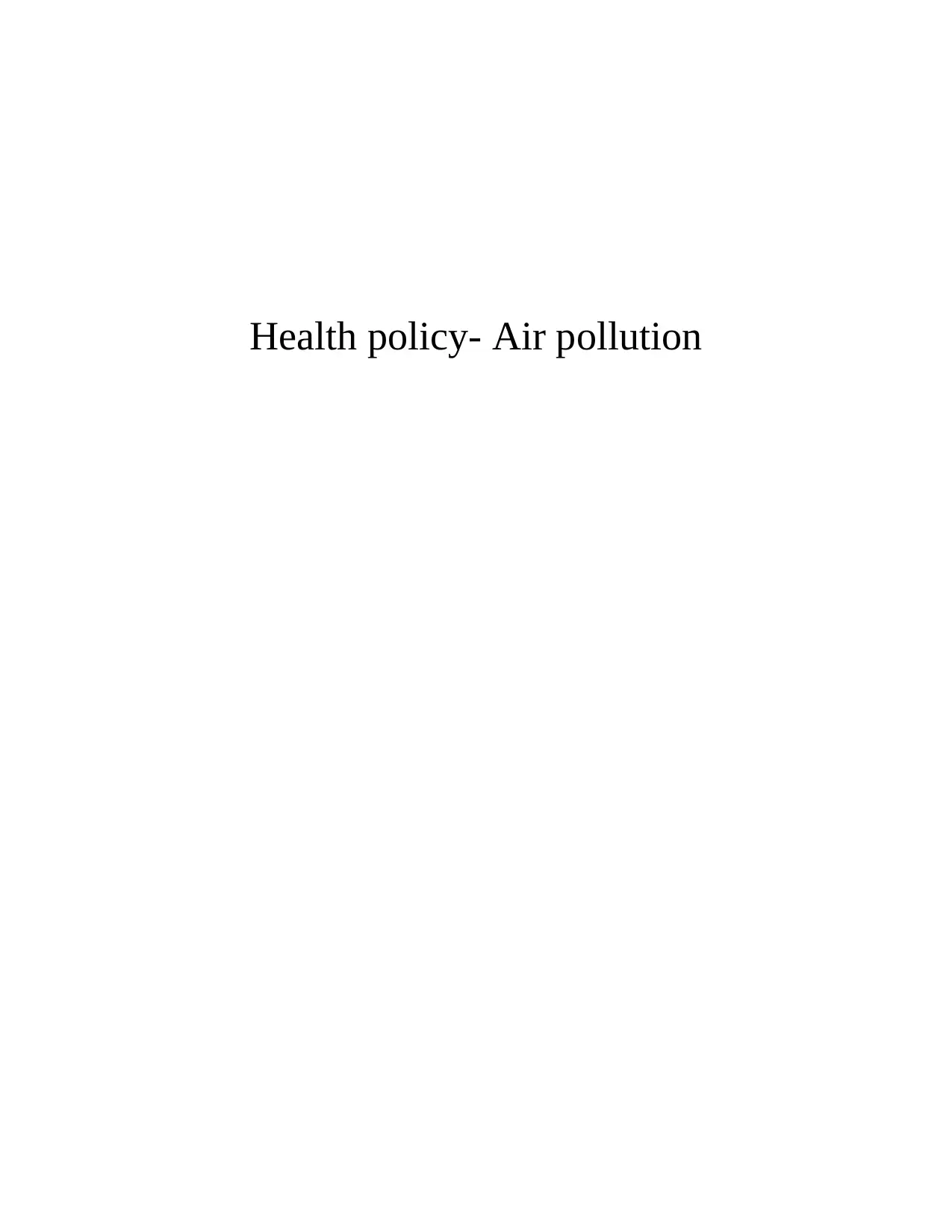
Health policy- Air pollution
Paraphrase This Document
Need a fresh take? Get an instant paraphrase of this document with our AI Paraphraser

Table of Contents
INTRODUCTION...........................................................................................................................1
MAIN BODY...................................................................................................................................1
TASK 1............................................................................................................................................1
Air pollution as a global health policy issue..........................................................................1
Concepts health, medical and social sciences in relation global health issues.......................4
Development of person-centric health and healthcare policies..............................................5
Various stages of policy development and their implementation..........................................6
CONCLUSION................................................................................................................................7
REFERENCES................................................................................................................................8
Online.....................................................................................................................................9
INTRODUCTION...........................................................................................................................1
MAIN BODY...................................................................................................................................1
TASK 1............................................................................................................................................1
Air pollution as a global health policy issue..........................................................................1
Concepts health, medical and social sciences in relation global health issues.......................4
Development of person-centric health and healthcare policies..............................................5
Various stages of policy development and their implementation..........................................6
CONCLUSION................................................................................................................................7
REFERENCES................................................................................................................................8
Online.....................................................................................................................................9
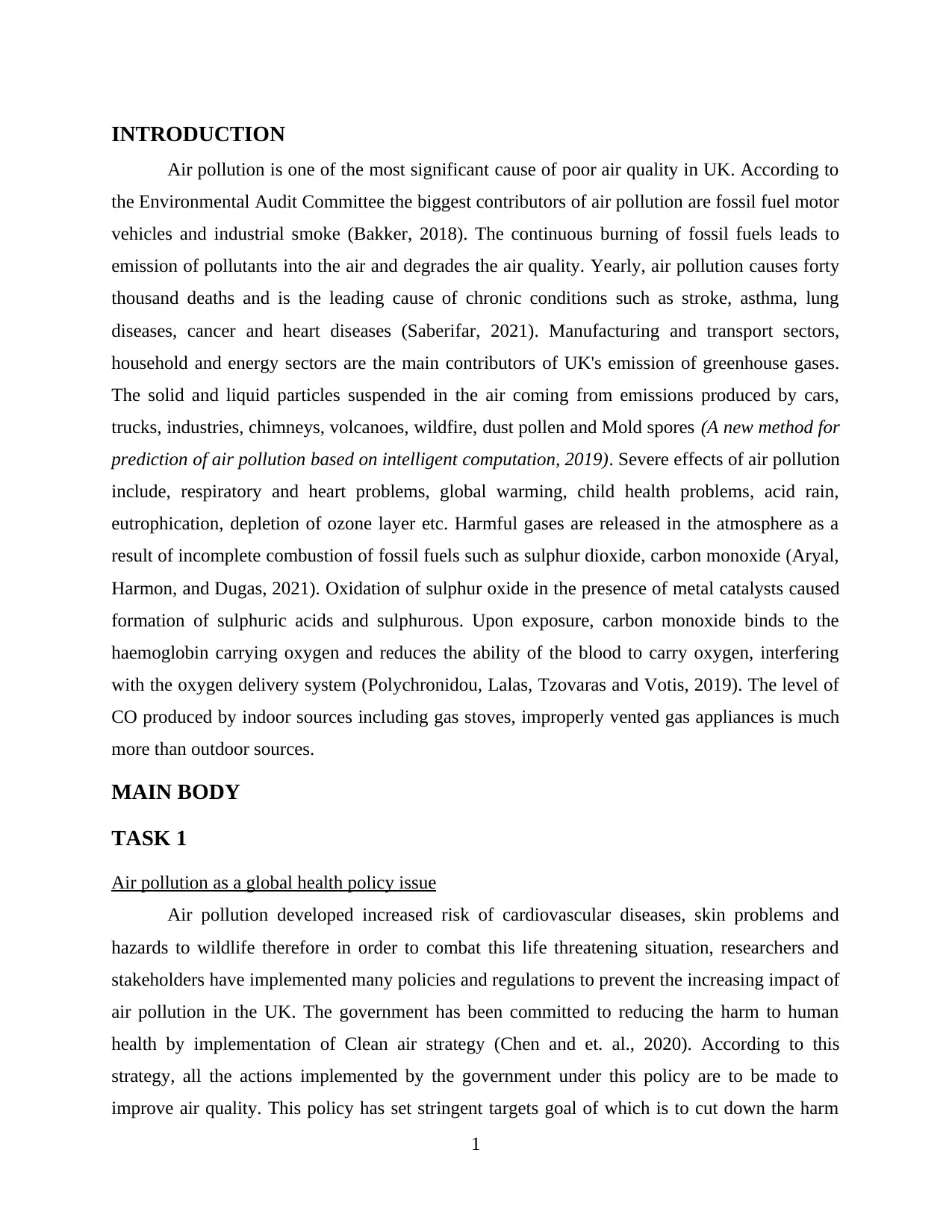
INTRODUCTION
Air pollution is one of the most significant cause of poor air quality in UK. According to
the Environmental Audit Committee the biggest contributors of air pollution are fossil fuel motor
vehicles and industrial smoke (Bakker, 2018). The continuous burning of fossil fuels leads to
emission of pollutants into the air and degrades the air quality. Yearly, air pollution causes forty
thousand deaths and is the leading cause of chronic conditions such as stroke, asthma, lung
diseases, cancer and heart diseases (Saberifar, 2021). Manufacturing and transport sectors,
household and energy sectors are the main contributors of UK's emission of greenhouse gases.
The solid and liquid particles suspended in the air coming from emissions produced by cars,
trucks, industries, chimneys, volcanoes, wildfire, dust pollen and Mold spores (A new method for
prediction of air pollution based on intelligent computation, 2019). Severe effects of air pollution
include, respiratory and heart problems, global warming, child health problems, acid rain,
eutrophication, depletion of ozone layer etc. Harmful gases are released in the atmosphere as a
result of incomplete combustion of fossil fuels such as sulphur dioxide, carbon monoxide (Aryal,
Harmon, and Dugas, 2021). Oxidation of sulphur oxide in the presence of metal catalysts caused
formation of sulphuric acids and sulphurous. Upon exposure, carbon monoxide binds to the
haemoglobin carrying oxygen and reduces the ability of the blood to carry oxygen, interfering
with the oxygen delivery system (Polychronidou, Lalas, Tzovaras and Votis, 2019). The level of
CO produced by indoor sources including gas stoves, improperly vented gas appliances is much
more than outdoor sources.
MAIN BODY
TASK 1
Air pollution as a global health policy issue
Air pollution developed increased risk of cardiovascular diseases, skin problems and
hazards to wildlife therefore in order to combat this life threatening situation, researchers and
stakeholders have implemented many policies and regulations to prevent the increasing impact of
air pollution in the UK. The government has been committed to reducing the harm to human
health by implementation of Clean air strategy (Chen and et. al., 2020). According to this
strategy, all the actions implemented by the government under this policy are to be made to
improve air quality. This policy has set stringent targets goal of which is to cut down the harm
1
Air pollution is one of the most significant cause of poor air quality in UK. According to
the Environmental Audit Committee the biggest contributors of air pollution are fossil fuel motor
vehicles and industrial smoke (Bakker, 2018). The continuous burning of fossil fuels leads to
emission of pollutants into the air and degrades the air quality. Yearly, air pollution causes forty
thousand deaths and is the leading cause of chronic conditions such as stroke, asthma, lung
diseases, cancer and heart diseases (Saberifar, 2021). Manufacturing and transport sectors,
household and energy sectors are the main contributors of UK's emission of greenhouse gases.
The solid and liquid particles suspended in the air coming from emissions produced by cars,
trucks, industries, chimneys, volcanoes, wildfire, dust pollen and Mold spores (A new method for
prediction of air pollution based on intelligent computation, 2019). Severe effects of air pollution
include, respiratory and heart problems, global warming, child health problems, acid rain,
eutrophication, depletion of ozone layer etc. Harmful gases are released in the atmosphere as a
result of incomplete combustion of fossil fuels such as sulphur dioxide, carbon monoxide (Aryal,
Harmon, and Dugas, 2021). Oxidation of sulphur oxide in the presence of metal catalysts caused
formation of sulphuric acids and sulphurous. Upon exposure, carbon monoxide binds to the
haemoglobin carrying oxygen and reduces the ability of the blood to carry oxygen, interfering
with the oxygen delivery system (Polychronidou, Lalas, Tzovaras and Votis, 2019). The level of
CO produced by indoor sources including gas stoves, improperly vented gas appliances is much
more than outdoor sources.
MAIN BODY
TASK 1
Air pollution as a global health policy issue
Air pollution developed increased risk of cardiovascular diseases, skin problems and
hazards to wildlife therefore in order to combat this life threatening situation, researchers and
stakeholders have implemented many policies and regulations to prevent the increasing impact of
air pollution in the UK. The government has been committed to reducing the harm to human
health by implementation of Clean air strategy (Chen and et. al., 2020). According to this
strategy, all the actions implemented by the government under this policy are to be made to
improve air quality. This policy has set stringent targets goal of which is to cut down the harm
1
⊘ This is a preview!⊘
Do you want full access?
Subscribe today to unlock all pages.

Trusted by 1+ million students worldwide
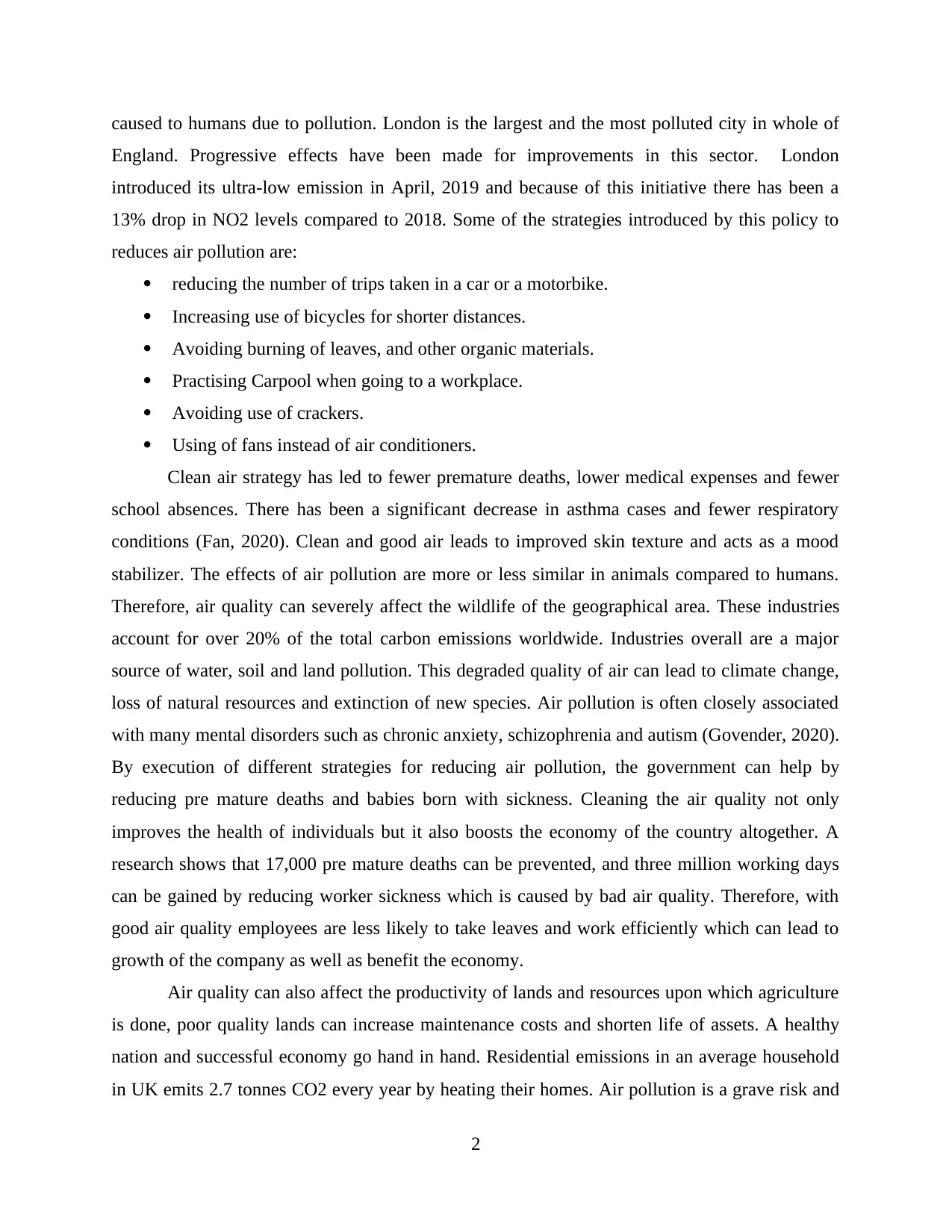
caused to humans due to pollution. London is the largest and the most polluted city in whole of
England. Progressive effects have been made for improvements in this sector. London
introduced its ultra-low emission in April, 2019 and because of this initiative there has been a
13% drop in NO2 levels compared to 2018. Some of the strategies introduced by this policy to
reduces air pollution are:
reducing the number of trips taken in a car or a motorbike.
Increasing use of bicycles for shorter distances.
Avoiding burning of leaves, and other organic materials.
Practising Carpool when going to a workplace.
Avoiding use of crackers.
Using of fans instead of air conditioners.
Clean air strategy has led to fewer premature deaths, lower medical expenses and fewer
school absences. There has been a significant decrease in asthma cases and fewer respiratory
conditions (Fan, 2020). Clean and good air leads to improved skin texture and acts as a mood
stabilizer. The effects of air pollution are more or less similar in animals compared to humans.
Therefore, air quality can severely affect the wildlife of the geographical area. These industries
account for over 20% of the total carbon emissions worldwide. Industries overall are a major
source of water, soil and land pollution. This degraded quality of air can lead to climate change,
loss of natural resources and extinction of new species. Air pollution is often closely associated
with many mental disorders such as chronic anxiety, schizophrenia and autism (Govender, 2020).
By execution of different strategies for reducing air pollution, the government can help by
reducing pre mature deaths and babies born with sickness. Cleaning the air quality not only
improves the health of individuals but it also boosts the economy of the country altogether. A
research shows that 17,000 pre mature deaths can be prevented, and three million working days
can be gained by reducing worker sickness which is caused by bad air quality. Therefore, with
good air quality employees are less likely to take leaves and work efficiently which can lead to
growth of the company as well as benefit the economy.
Air quality can also affect the productivity of lands and resources upon which agriculture
is done, poor quality lands can increase maintenance costs and shorten life of assets. A healthy
nation and successful economy go hand in hand. Residential emissions in an average household
in UK emits 2.7 tonnes CO2 every year by heating their homes. Air pollution is a grave risk and
2
England. Progressive effects have been made for improvements in this sector. London
introduced its ultra-low emission in April, 2019 and because of this initiative there has been a
13% drop in NO2 levels compared to 2018. Some of the strategies introduced by this policy to
reduces air pollution are:
reducing the number of trips taken in a car or a motorbike.
Increasing use of bicycles for shorter distances.
Avoiding burning of leaves, and other organic materials.
Practising Carpool when going to a workplace.
Avoiding use of crackers.
Using of fans instead of air conditioners.
Clean air strategy has led to fewer premature deaths, lower medical expenses and fewer
school absences. There has been a significant decrease in asthma cases and fewer respiratory
conditions (Fan, 2020). Clean and good air leads to improved skin texture and acts as a mood
stabilizer. The effects of air pollution are more or less similar in animals compared to humans.
Therefore, air quality can severely affect the wildlife of the geographical area. These industries
account for over 20% of the total carbon emissions worldwide. Industries overall are a major
source of water, soil and land pollution. This degraded quality of air can lead to climate change,
loss of natural resources and extinction of new species. Air pollution is often closely associated
with many mental disorders such as chronic anxiety, schizophrenia and autism (Govender, 2020).
By execution of different strategies for reducing air pollution, the government can help by
reducing pre mature deaths and babies born with sickness. Cleaning the air quality not only
improves the health of individuals but it also boosts the economy of the country altogether. A
research shows that 17,000 pre mature deaths can be prevented, and three million working days
can be gained by reducing worker sickness which is caused by bad air quality. Therefore, with
good air quality employees are less likely to take leaves and work efficiently which can lead to
growth of the company as well as benefit the economy.
Air quality can also affect the productivity of lands and resources upon which agriculture
is done, poor quality lands can increase maintenance costs and shorten life of assets. A healthy
nation and successful economy go hand in hand. Residential emissions in an average household
in UK emits 2.7 tonnes CO2 every year by heating their homes. Air pollution is a grave risk and
2
Paraphrase This Document
Need a fresh take? Get an instant paraphrase of this document with our AI Paraphraser
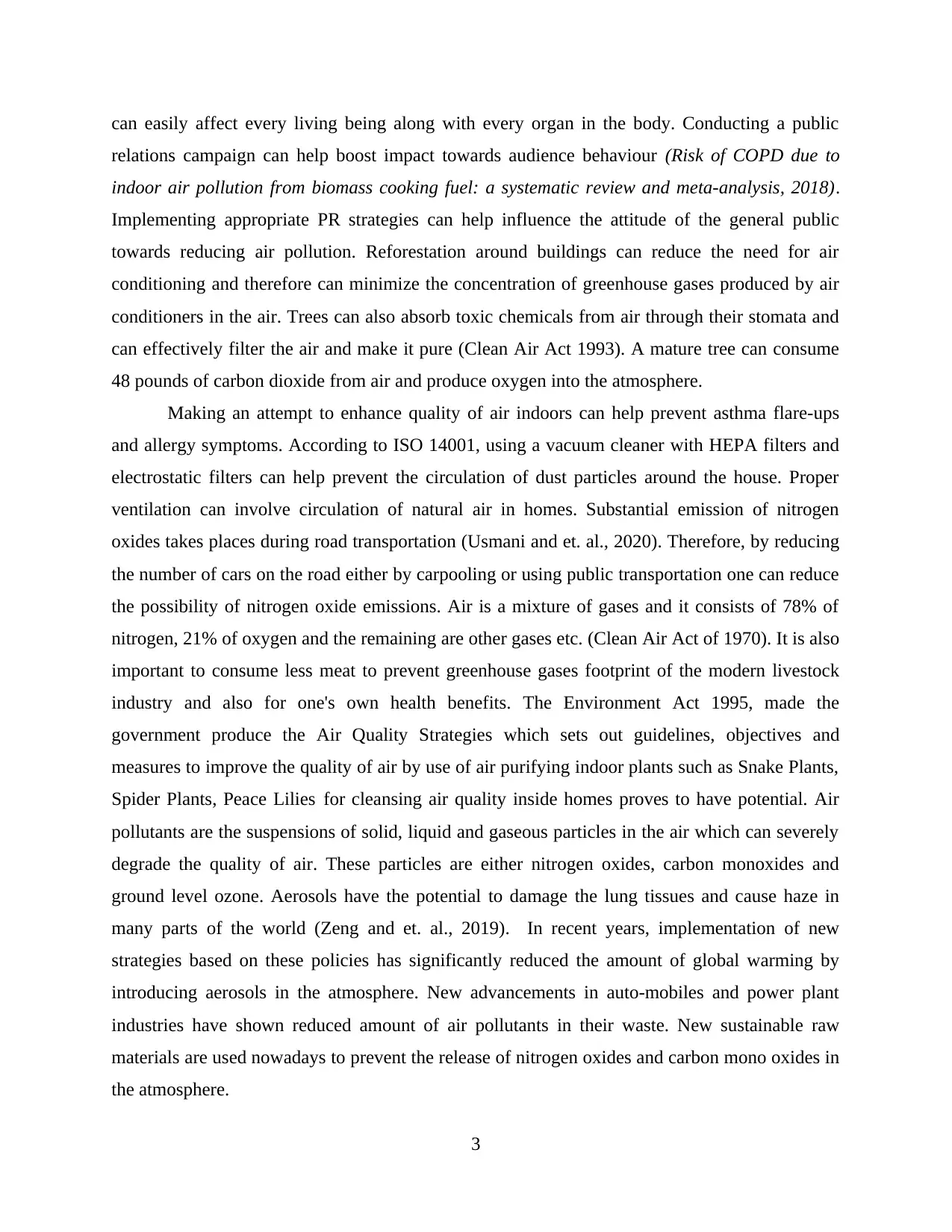
can easily affect every living being along with every organ in the body. Conducting a public
relations campaign can help boost impact towards audience behaviour (Risk of COPD due to
indoor air pollution from biomass cooking fuel: a systematic review and meta-analysis, 2018).
Implementing appropriate PR strategies can help influence the attitude of the general public
towards reducing air pollution. Reforestation around buildings can reduce the need for air
conditioning and therefore can minimize the concentration of greenhouse gases produced by air
conditioners in the air. Trees can also absorb toxic chemicals from air through their stomata and
can effectively filter the air and make it pure (Clean Air Act 1993). A mature tree can consume
48 pounds of carbon dioxide from air and produce oxygen into the atmosphere.
Making an attempt to enhance quality of air indoors can help prevent asthma flare-ups
and allergy symptoms. According to ISO 14001, using a vacuum cleaner with HEPA filters and
electrostatic filters can help prevent the circulation of dust particles around the house. Proper
ventilation can involve circulation of natural air in homes. Substantial emission of nitrogen
oxides takes places during road transportation (Usmani and et. al., 2020). Therefore, by reducing
the number of cars on the road either by carpooling or using public transportation one can reduce
the possibility of nitrogen oxide emissions. Air is a mixture of gases and it consists of 78% of
nitrogen, 21% of oxygen and the remaining are other gases etc. (Clean Air Act of 1970). It is also
important to consume less meat to prevent greenhouse gases footprint of the modern livestock
industry and also for one's own health benefits. The Environment Act 1995, made the
government produce the Air Quality Strategies which sets out guidelines, objectives and
measures to improve the quality of air by use of air purifying indoor plants such as Snake Plants,
Spider Plants, Peace Lilies for cleansing air quality inside homes proves to have potential. Air
pollutants are the suspensions of solid, liquid and gaseous particles in the air which can severely
degrade the quality of air. These particles are either nitrogen oxides, carbon monoxides and
ground level ozone. Aerosols have the potential to damage the lung tissues and cause haze in
many parts of the world (Zeng and et. al., 2019). In recent years, implementation of new
strategies based on these policies has significantly reduced the amount of global warming by
introducing aerosols in the atmosphere. New advancements in auto-mobiles and power plant
industries have shown reduced amount of air pollutants in their waste. New sustainable raw
materials are used nowadays to prevent the release of nitrogen oxides and carbon mono oxides in
the atmosphere.
3
relations campaign can help boost impact towards audience behaviour (Risk of COPD due to
indoor air pollution from biomass cooking fuel: a systematic review and meta-analysis, 2018).
Implementing appropriate PR strategies can help influence the attitude of the general public
towards reducing air pollution. Reforestation around buildings can reduce the need for air
conditioning and therefore can minimize the concentration of greenhouse gases produced by air
conditioners in the air. Trees can also absorb toxic chemicals from air through their stomata and
can effectively filter the air and make it pure (Clean Air Act 1993). A mature tree can consume
48 pounds of carbon dioxide from air and produce oxygen into the atmosphere.
Making an attempt to enhance quality of air indoors can help prevent asthma flare-ups
and allergy symptoms. According to ISO 14001, using a vacuum cleaner with HEPA filters and
electrostatic filters can help prevent the circulation of dust particles around the house. Proper
ventilation can involve circulation of natural air in homes. Substantial emission of nitrogen
oxides takes places during road transportation (Usmani and et. al., 2020). Therefore, by reducing
the number of cars on the road either by carpooling or using public transportation one can reduce
the possibility of nitrogen oxide emissions. Air is a mixture of gases and it consists of 78% of
nitrogen, 21% of oxygen and the remaining are other gases etc. (Clean Air Act of 1970). It is also
important to consume less meat to prevent greenhouse gases footprint of the modern livestock
industry and also for one's own health benefits. The Environment Act 1995, made the
government produce the Air Quality Strategies which sets out guidelines, objectives and
measures to improve the quality of air by use of air purifying indoor plants such as Snake Plants,
Spider Plants, Peace Lilies for cleansing air quality inside homes proves to have potential. Air
pollutants are the suspensions of solid, liquid and gaseous particles in the air which can severely
degrade the quality of air. These particles are either nitrogen oxides, carbon monoxides and
ground level ozone. Aerosols have the potential to damage the lung tissues and cause haze in
many parts of the world (Zeng and et. al., 2019). In recent years, implementation of new
strategies based on these policies has significantly reduced the amount of global warming by
introducing aerosols in the atmosphere. New advancements in auto-mobiles and power plant
industries have shown reduced amount of air pollutants in their waste. New sustainable raw
materials are used nowadays to prevent the release of nitrogen oxides and carbon mono oxides in
the atmosphere.
3
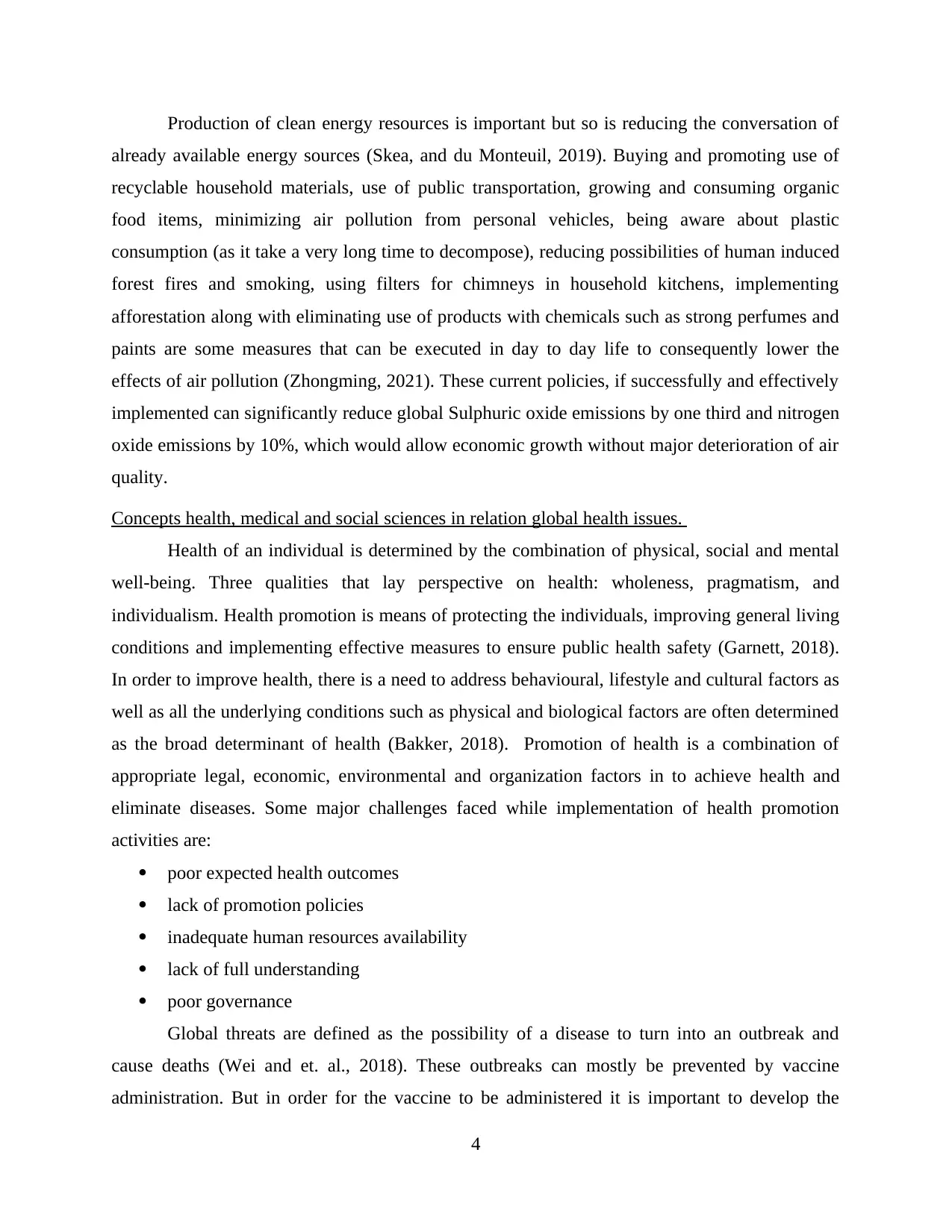
Production of clean energy resources is important but so is reducing the conversation of
already available energy sources (Skea, and du Monteuil, 2019). Buying and promoting use of
recyclable household materials, use of public transportation, growing and consuming organic
food items, minimizing air pollution from personal vehicles, being aware about plastic
consumption (as it take a very long time to decompose), reducing possibilities of human induced
forest fires and smoking, using filters for chimneys in household kitchens, implementing
afforestation along with eliminating use of products with chemicals such as strong perfumes and
paints are some measures that can be executed in day to day life to consequently lower the
effects of air pollution (Zhongming, 2021). These current policies, if successfully and effectively
implemented can significantly reduce global Sulphuric oxide emissions by one third and nitrogen
oxide emissions by 10%, which would allow economic growth without major deterioration of air
quality.
Concepts health, medical and social sciences in relation global health issues.
Health of an individual is determined by the combination of physical, social and mental
well-being. Three qualities that lay perspective on health: wholeness, pragmatism, and
individualism. Health promotion is means of protecting the individuals, improving general living
conditions and implementing effective measures to ensure public health safety (Garnett, 2018).
In order to improve health, there is a need to address behavioural, lifestyle and cultural factors as
well as all the underlying conditions such as physical and biological factors are often determined
as the broad determinant of health (Bakker, 2018). Promotion of health is a combination of
appropriate legal, economic, environmental and organization factors in to achieve health and
eliminate diseases. Some major challenges faced while implementation of health promotion
activities are:
poor expected health outcomes
lack of promotion policies
inadequate human resources availability
lack of full understanding
poor governance
Global threats are defined as the possibility of a disease to turn into an outbreak and
cause deaths (Wei and et. al., 2018). These outbreaks can mostly be prevented by vaccine
administration. But in order for the vaccine to be administered it is important to develop the
4
already available energy sources (Skea, and du Monteuil, 2019). Buying and promoting use of
recyclable household materials, use of public transportation, growing and consuming organic
food items, minimizing air pollution from personal vehicles, being aware about plastic
consumption (as it take a very long time to decompose), reducing possibilities of human induced
forest fires and smoking, using filters for chimneys in household kitchens, implementing
afforestation along with eliminating use of products with chemicals such as strong perfumes and
paints are some measures that can be executed in day to day life to consequently lower the
effects of air pollution (Zhongming, 2021). These current policies, if successfully and effectively
implemented can significantly reduce global Sulphuric oxide emissions by one third and nitrogen
oxide emissions by 10%, which would allow economic growth without major deterioration of air
quality.
Concepts health, medical and social sciences in relation global health issues.
Health of an individual is determined by the combination of physical, social and mental
well-being. Three qualities that lay perspective on health: wholeness, pragmatism, and
individualism. Health promotion is means of protecting the individuals, improving general living
conditions and implementing effective measures to ensure public health safety (Garnett, 2018).
In order to improve health, there is a need to address behavioural, lifestyle and cultural factors as
well as all the underlying conditions such as physical and biological factors are often determined
as the broad determinant of health (Bakker, 2018). Promotion of health is a combination of
appropriate legal, economic, environmental and organization factors in to achieve health and
eliminate diseases. Some major challenges faced while implementation of health promotion
activities are:
poor expected health outcomes
lack of promotion policies
inadequate human resources availability
lack of full understanding
poor governance
Global threats are defined as the possibility of a disease to turn into an outbreak and
cause deaths (Wei and et. al., 2018). These outbreaks can mostly be prevented by vaccine
administration. But in order for the vaccine to be administered it is important to develop the
4
⊘ This is a preview!⊘
Do you want full access?
Subscribe today to unlock all pages.

Trusted by 1+ million students worldwide
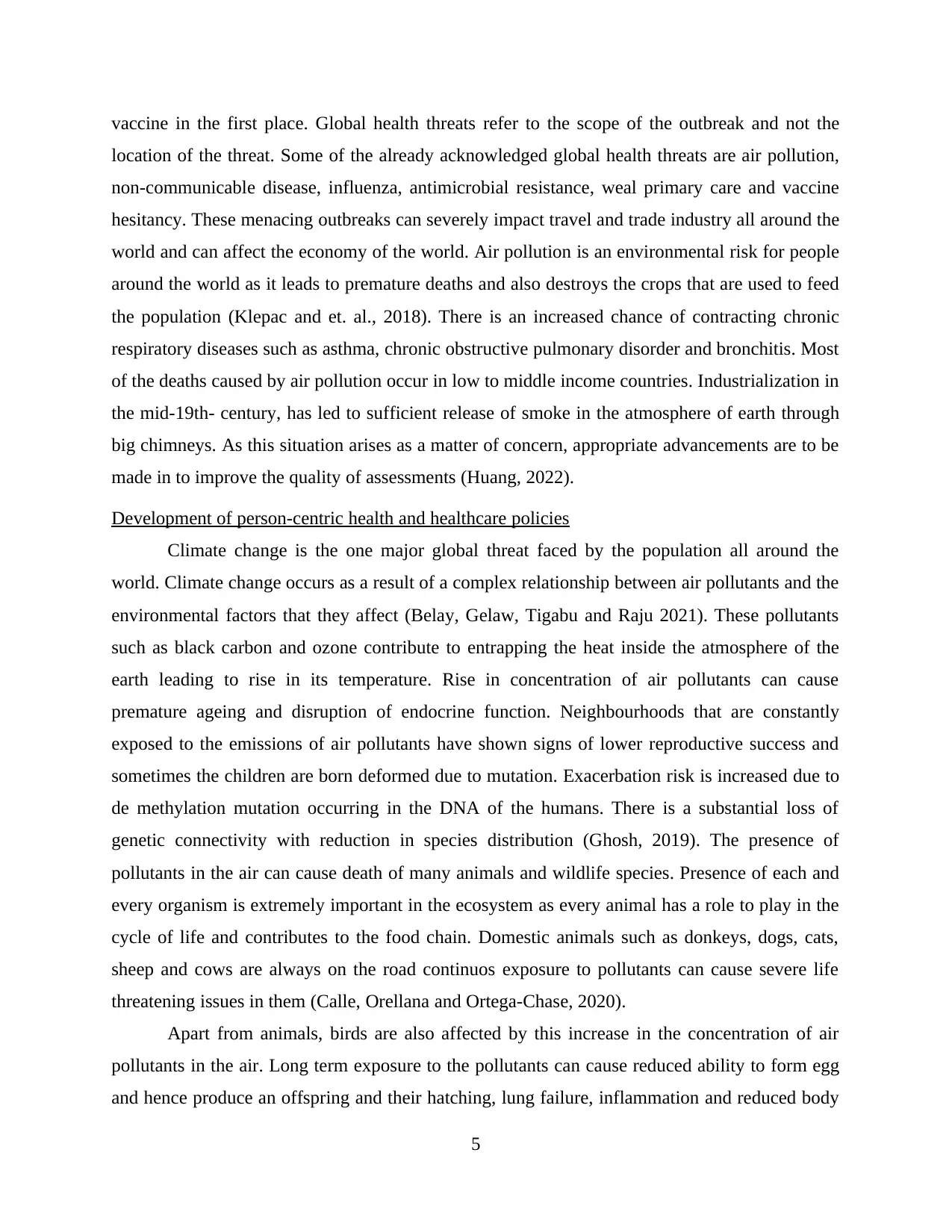
vaccine in the first place. Global health threats refer to the scope of the outbreak and not the
location of the threat. Some of the already acknowledged global health threats are air pollution,
non-communicable disease, influenza, antimicrobial resistance, weal primary care and vaccine
hesitancy. These menacing outbreaks can severely impact travel and trade industry all around the
world and can affect the economy of the world. Air pollution is an environmental risk for people
around the world as it leads to premature deaths and also destroys the crops that are used to feed
the population (Klepac and et. al., 2018). There is an increased chance of contracting chronic
respiratory diseases such as asthma, chronic obstructive pulmonary disorder and bronchitis. Most
of the deaths caused by air pollution occur in low to middle income countries. Industrialization in
the mid-19th- century, has led to sufficient release of smoke in the atmosphere of earth through
big chimneys. As this situation arises as a matter of concern, appropriate advancements are to be
made in to improve the quality of assessments (Huang, 2022).
Development of person-centric health and healthcare policies
Climate change is the one major global threat faced by the population all around the
world. Climate change occurs as a result of a complex relationship between air pollutants and the
environmental factors that they affect (Belay, Gelaw, Tigabu and Raju 2021). These pollutants
such as black carbon and ozone contribute to entrapping the heat inside the atmosphere of the
earth leading to rise in its temperature. Rise in concentration of air pollutants can cause
premature ageing and disruption of endocrine function. Neighbourhoods that are constantly
exposed to the emissions of air pollutants have shown signs of lower reproductive success and
sometimes the children are born deformed due to mutation. Exacerbation risk is increased due to
de methylation mutation occurring in the DNA of the humans. There is a substantial loss of
genetic connectivity with reduction in species distribution (Ghosh, 2019). The presence of
pollutants in the air can cause death of many animals and wildlife species. Presence of each and
every organism is extremely important in the ecosystem as every animal has a role to play in the
cycle of life and contributes to the food chain. Domestic animals such as donkeys, dogs, cats,
sheep and cows are always on the road continuos exposure to pollutants can cause severe life
threatening issues in them (Calle, Orellana and Ortega-Chase, 2020).
Apart from animals, birds are also affected by this increase in the concentration of air
pollutants in the air. Long term exposure to the pollutants can cause reduced ability to form egg
and hence produce an offspring and their hatching, lung failure, inflammation and reduced body
5
location of the threat. Some of the already acknowledged global health threats are air pollution,
non-communicable disease, influenza, antimicrobial resistance, weal primary care and vaccine
hesitancy. These menacing outbreaks can severely impact travel and trade industry all around the
world and can affect the economy of the world. Air pollution is an environmental risk for people
around the world as it leads to premature deaths and also destroys the crops that are used to feed
the population (Klepac and et. al., 2018). There is an increased chance of contracting chronic
respiratory diseases such as asthma, chronic obstructive pulmonary disorder and bronchitis. Most
of the deaths caused by air pollution occur in low to middle income countries. Industrialization in
the mid-19th- century, has led to sufficient release of smoke in the atmosphere of earth through
big chimneys. As this situation arises as a matter of concern, appropriate advancements are to be
made in to improve the quality of assessments (Huang, 2022).
Development of person-centric health and healthcare policies
Climate change is the one major global threat faced by the population all around the
world. Climate change occurs as a result of a complex relationship between air pollutants and the
environmental factors that they affect (Belay, Gelaw, Tigabu and Raju 2021). These pollutants
such as black carbon and ozone contribute to entrapping the heat inside the atmosphere of the
earth leading to rise in its temperature. Rise in concentration of air pollutants can cause
premature ageing and disruption of endocrine function. Neighbourhoods that are constantly
exposed to the emissions of air pollutants have shown signs of lower reproductive success and
sometimes the children are born deformed due to mutation. Exacerbation risk is increased due to
de methylation mutation occurring in the DNA of the humans. There is a substantial loss of
genetic connectivity with reduction in species distribution (Ghosh, 2019). The presence of
pollutants in the air can cause death of many animals and wildlife species. Presence of each and
every organism is extremely important in the ecosystem as every animal has a role to play in the
cycle of life and contributes to the food chain. Domestic animals such as donkeys, dogs, cats,
sheep and cows are always on the road continuos exposure to pollutants can cause severe life
threatening issues in them (Calle, Orellana and Ortega-Chase, 2020).
Apart from animals, birds are also affected by this increase in the concentration of air
pollutants in the air. Long term exposure to the pollutants can cause reduced ability to form egg
and hence produce an offspring and their hatching, lung failure, inflammation and reduced body
5
Paraphrase This Document
Need a fresh take? Get an instant paraphrase of this document with our AI Paraphraser
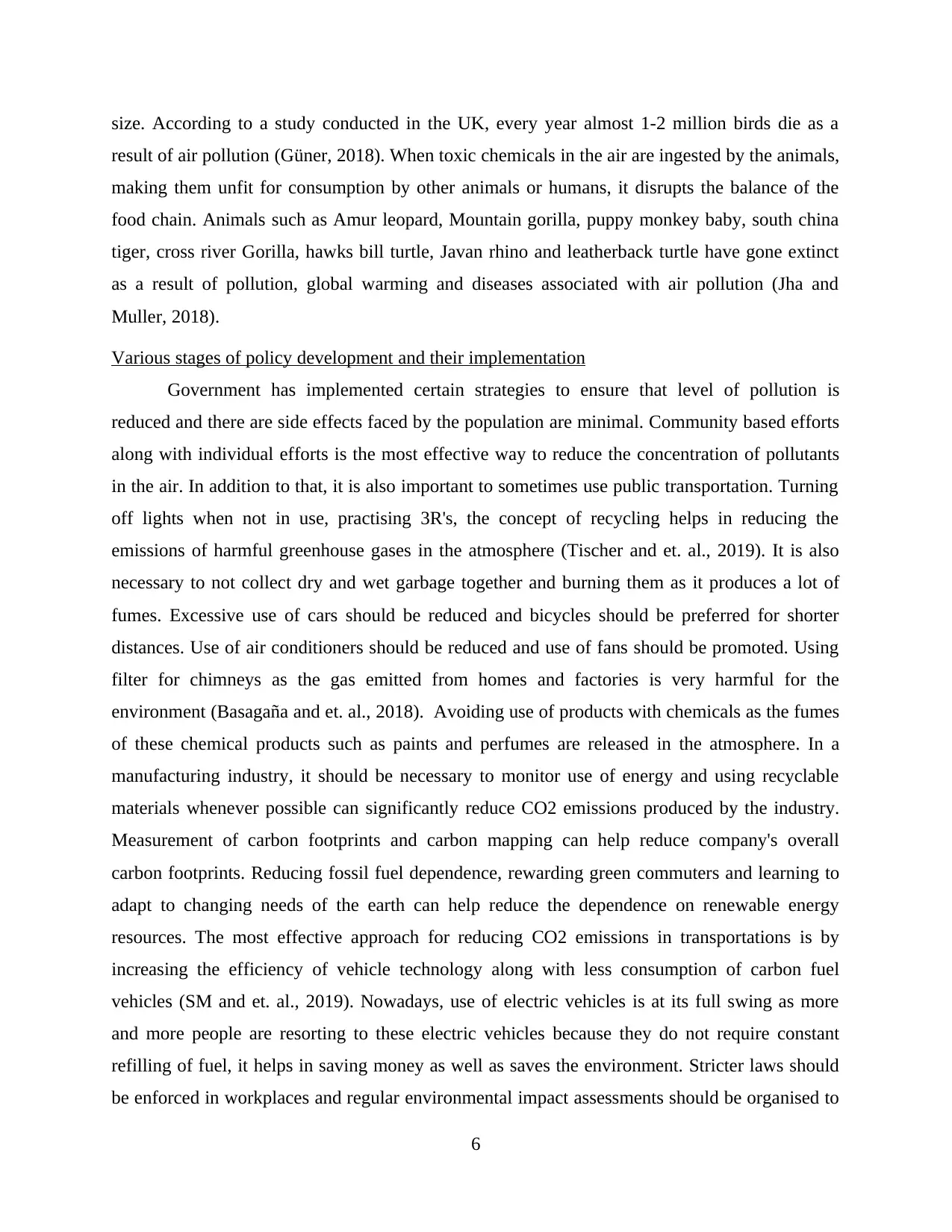
size. According to a study conducted in the UK, every year almost 1-2 million birds die as a
result of air pollution (Güner, 2018). When toxic chemicals in the air are ingested by the animals,
making them unfit for consumption by other animals or humans, it disrupts the balance of the
food chain. Animals such as Amur leopard, Mountain gorilla, puppy monkey baby, south china
tiger, cross river Gorilla, hawks bill turtle, Javan rhino and leatherback turtle have gone extinct
as a result of pollution, global warming and diseases associated with air pollution (Jha and
Muller, 2018).
Various stages of policy development and their implementation
Government has implemented certain strategies to ensure that level of pollution is
reduced and there are side effects faced by the population are minimal. Community based efforts
along with individual efforts is the most effective way to reduce the concentration of pollutants
in the air. In addition to that, it is also important to sometimes use public transportation. Turning
off lights when not in use, practising 3R's, the concept of recycling helps in reducing the
emissions of harmful greenhouse gases in the atmosphere (Tischer and et. al., 2019). It is also
necessary to not collect dry and wet garbage together and burning them as it produces a lot of
fumes. Excessive use of cars should be reduced and bicycles should be preferred for shorter
distances. Use of air conditioners should be reduced and use of fans should be promoted. Using
filter for chimneys as the gas emitted from homes and factories is very harmful for the
environment (Basagaña and et. al., 2018). Avoiding use of products with chemicals as the fumes
of these chemical products such as paints and perfumes are released in the atmosphere. In a
manufacturing industry, it should be necessary to monitor use of energy and using recyclable
materials whenever possible can significantly reduce CO2 emissions produced by the industry.
Measurement of carbon footprints and carbon mapping can help reduce company's overall
carbon footprints. Reducing fossil fuel dependence, rewarding green commuters and learning to
adapt to changing needs of the earth can help reduce the dependence on renewable energy
resources. The most effective approach for reducing CO2 emissions in transportations is by
increasing the efficiency of vehicle technology along with less consumption of carbon fuel
vehicles (SM and et. al., 2019). Nowadays, use of electric vehicles is at its full swing as more
and more people are resorting to these electric vehicles because they do not require constant
refilling of fuel, it helps in saving money as well as saves the environment. Stricter laws should
be enforced in workplaces and regular environmental impact assessments should be organised to
6
result of air pollution (Güner, 2018). When toxic chemicals in the air are ingested by the animals,
making them unfit for consumption by other animals or humans, it disrupts the balance of the
food chain. Animals such as Amur leopard, Mountain gorilla, puppy monkey baby, south china
tiger, cross river Gorilla, hawks bill turtle, Javan rhino and leatherback turtle have gone extinct
as a result of pollution, global warming and diseases associated with air pollution (Jha and
Muller, 2018).
Various stages of policy development and their implementation
Government has implemented certain strategies to ensure that level of pollution is
reduced and there are side effects faced by the population are minimal. Community based efforts
along with individual efforts is the most effective way to reduce the concentration of pollutants
in the air. In addition to that, it is also important to sometimes use public transportation. Turning
off lights when not in use, practising 3R's, the concept of recycling helps in reducing the
emissions of harmful greenhouse gases in the atmosphere (Tischer and et. al., 2019). It is also
necessary to not collect dry and wet garbage together and burning them as it produces a lot of
fumes. Excessive use of cars should be reduced and bicycles should be preferred for shorter
distances. Use of air conditioners should be reduced and use of fans should be promoted. Using
filter for chimneys as the gas emitted from homes and factories is very harmful for the
environment (Basagaña and et. al., 2018). Avoiding use of products with chemicals as the fumes
of these chemical products such as paints and perfumes are released in the atmosphere. In a
manufacturing industry, it should be necessary to monitor use of energy and using recyclable
materials whenever possible can significantly reduce CO2 emissions produced by the industry.
Measurement of carbon footprints and carbon mapping can help reduce company's overall
carbon footprints. Reducing fossil fuel dependence, rewarding green commuters and learning to
adapt to changing needs of the earth can help reduce the dependence on renewable energy
resources. The most effective approach for reducing CO2 emissions in transportations is by
increasing the efficiency of vehicle technology along with less consumption of carbon fuel
vehicles (SM and et. al., 2019). Nowadays, use of electric vehicles is at its full swing as more
and more people are resorting to these electric vehicles because they do not require constant
refilling of fuel, it helps in saving money as well as saves the environment. Stricter laws should
be enforced in workplaces and regular environmental impact assessments should be organised to
6
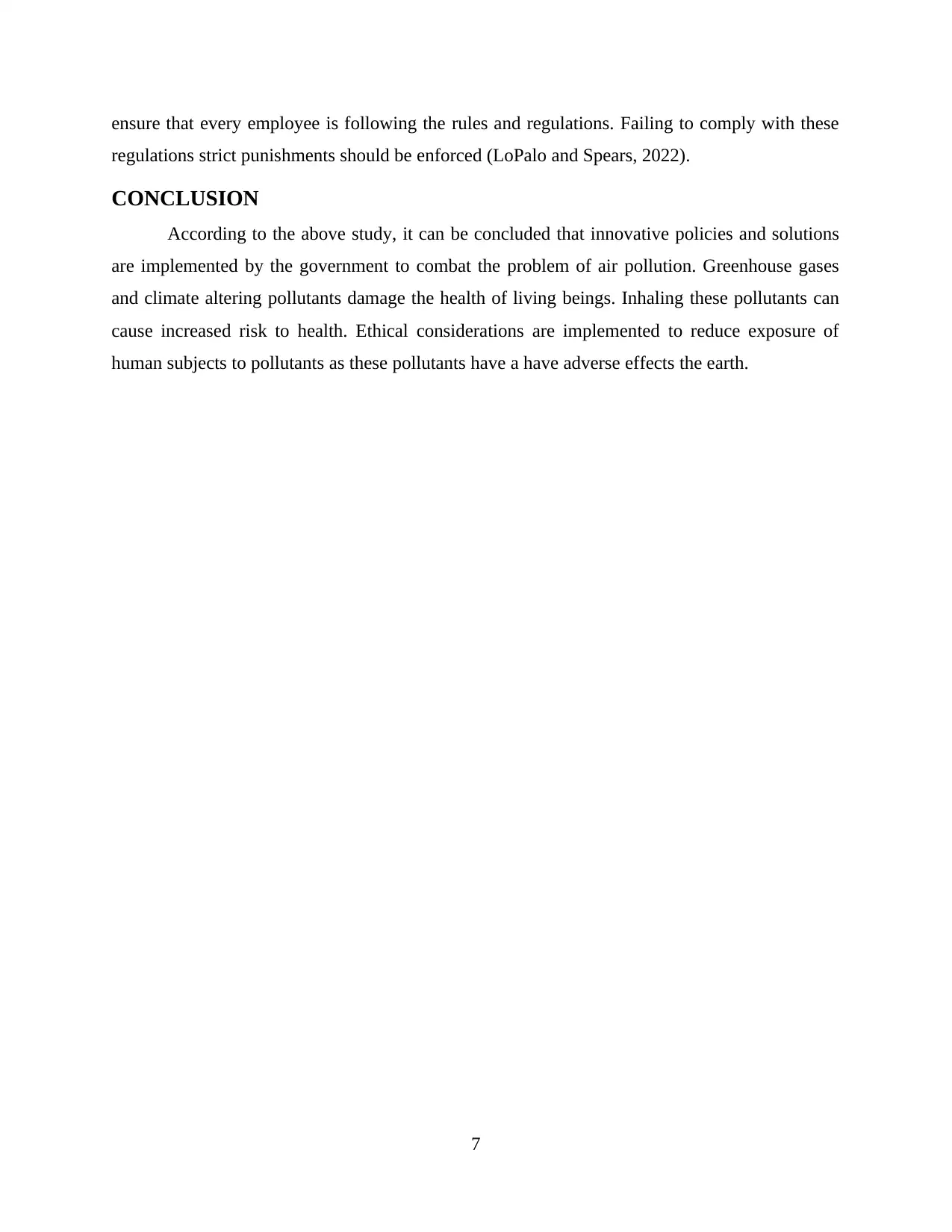
ensure that every employee is following the rules and regulations. Failing to comply with these
regulations strict punishments should be enforced (LoPalo and Spears, 2022).
CONCLUSION
According to the above study, it can be concluded that innovative policies and solutions
are implemented by the government to combat the problem of air pollution. Greenhouse gases
and climate altering pollutants damage the health of living beings. Inhaling these pollutants can
cause increased risk to health. Ethical considerations are implemented to reduce exposure of
human subjects to pollutants as these pollutants have a have adverse effects the earth.
7
regulations strict punishments should be enforced (LoPalo and Spears, 2022).
CONCLUSION
According to the above study, it can be concluded that innovative policies and solutions
are implemented by the government to combat the problem of air pollution. Greenhouse gases
and climate altering pollutants damage the health of living beings. Inhaling these pollutants can
cause increased risk to health. Ethical considerations are implemented to reduce exposure of
human subjects to pollutants as these pollutants have a have adverse effects the earth.
7
⊘ This is a preview!⊘
Do you want full access?
Subscribe today to unlock all pages.

Trusted by 1+ million students worldwide
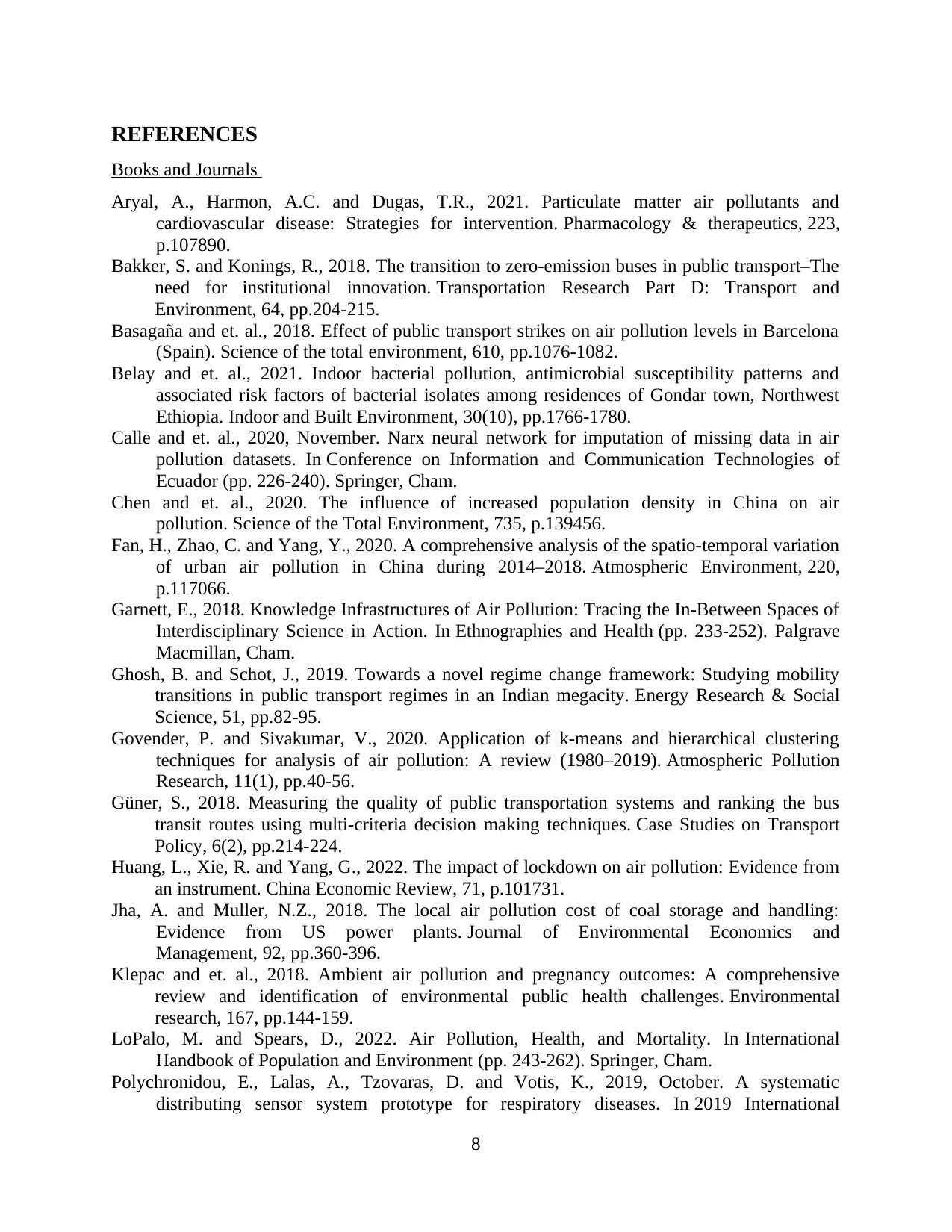
REFERENCES
Books and Journals
Aryal, A., Harmon, A.C. and Dugas, T.R., 2021. Particulate matter air pollutants and
cardiovascular disease: Strategies for intervention. Pharmacology & therapeutics, 223,
p.107890.
Bakker, S. and Konings, R., 2018. The transition to zero-emission buses in public transport–The
need for institutional innovation. Transportation Research Part D: Transport and
Environment, 64, pp.204-215.
Basagaña and et. al., 2018. Effect of public transport strikes on air pollution levels in Barcelona
(Spain). Science of the total environment, 610, pp.1076-1082.
Belay and et. al., 2021. Indoor bacterial pollution, antimicrobial susceptibility patterns and
associated risk factors of bacterial isolates among residences of Gondar town, Northwest
Ethiopia. Indoor and Built Environment, 30(10), pp.1766-1780.
Calle and et. al., 2020, November. Narx neural network for imputation of missing data in air
pollution datasets. In Conference on Information and Communication Technologies of
Ecuador (pp. 226-240). Springer, Cham.
Chen and et. al., 2020. The influence of increased population density in China on air
pollution. Science of the Total Environment, 735, p.139456.
Fan, H., Zhao, C. and Yang, Y., 2020. A comprehensive analysis of the spatio-temporal variation
of urban air pollution in China during 2014–2018. Atmospheric Environment, 220,
p.117066.
Garnett, E., 2018. Knowledge Infrastructures of Air Pollution: Tracing the In-Between Spaces of
Interdisciplinary Science in Action. In Ethnographies and Health (pp. 233-252). Palgrave
Macmillan, Cham.
Ghosh, B. and Schot, J., 2019. Towards a novel regime change framework: Studying mobility
transitions in public transport regimes in an Indian megacity. Energy Research & Social
Science, 51, pp.82-95.
Govender, P. and Sivakumar, V., 2020. Application of k-means and hierarchical clustering
techniques for analysis of air pollution: A review (1980–2019). Atmospheric Pollution
Research, 11(1), pp.40-56.
Güner, S., 2018. Measuring the quality of public transportation systems and ranking the bus
transit routes using multi-criteria decision making techniques. Case Studies on Transport
Policy, 6(2), pp.214-224.
Huang, L., Xie, R. and Yang, G., 2022. The impact of lockdown on air pollution: Evidence from
an instrument. China Economic Review, 71, p.101731.
Jha, A. and Muller, N.Z., 2018. The local air pollution cost of coal storage and handling:
Evidence from US power plants. Journal of Environmental Economics and
Management, 92, pp.360-396.
Klepac and et. al., 2018. Ambient air pollution and pregnancy outcomes: A comprehensive
review and identification of environmental public health challenges. Environmental
research, 167, pp.144-159.
LoPalo, M. and Spears, D., 2022. Air Pollution, Health, and Mortality. In International
Handbook of Population and Environment (pp. 243-262). Springer, Cham.
Polychronidou, E., Lalas, A., Tzovaras, D. and Votis, K., 2019, October. A systematic
distributing sensor system prototype for respiratory diseases. In 2019 International
8
Books and Journals
Aryal, A., Harmon, A.C. and Dugas, T.R., 2021. Particulate matter air pollutants and
cardiovascular disease: Strategies for intervention. Pharmacology & therapeutics, 223,
p.107890.
Bakker, S. and Konings, R., 2018. The transition to zero-emission buses in public transport–The
need for institutional innovation. Transportation Research Part D: Transport and
Environment, 64, pp.204-215.
Basagaña and et. al., 2018. Effect of public transport strikes on air pollution levels in Barcelona
(Spain). Science of the total environment, 610, pp.1076-1082.
Belay and et. al., 2021. Indoor bacterial pollution, antimicrobial susceptibility patterns and
associated risk factors of bacterial isolates among residences of Gondar town, Northwest
Ethiopia. Indoor and Built Environment, 30(10), pp.1766-1780.
Calle and et. al., 2020, November. Narx neural network for imputation of missing data in air
pollution datasets. In Conference on Information and Communication Technologies of
Ecuador (pp. 226-240). Springer, Cham.
Chen and et. al., 2020. The influence of increased population density in China on air
pollution. Science of the Total Environment, 735, p.139456.
Fan, H., Zhao, C. and Yang, Y., 2020. A comprehensive analysis of the spatio-temporal variation
of urban air pollution in China during 2014–2018. Atmospheric Environment, 220,
p.117066.
Garnett, E., 2018. Knowledge Infrastructures of Air Pollution: Tracing the In-Between Spaces of
Interdisciplinary Science in Action. In Ethnographies and Health (pp. 233-252). Palgrave
Macmillan, Cham.
Ghosh, B. and Schot, J., 2019. Towards a novel regime change framework: Studying mobility
transitions in public transport regimes in an Indian megacity. Energy Research & Social
Science, 51, pp.82-95.
Govender, P. and Sivakumar, V., 2020. Application of k-means and hierarchical clustering
techniques for analysis of air pollution: A review (1980–2019). Atmospheric Pollution
Research, 11(1), pp.40-56.
Güner, S., 2018. Measuring the quality of public transportation systems and ranking the bus
transit routes using multi-criteria decision making techniques. Case Studies on Transport
Policy, 6(2), pp.214-224.
Huang, L., Xie, R. and Yang, G., 2022. The impact of lockdown on air pollution: Evidence from
an instrument. China Economic Review, 71, p.101731.
Jha, A. and Muller, N.Z., 2018. The local air pollution cost of coal storage and handling:
Evidence from US power plants. Journal of Environmental Economics and
Management, 92, pp.360-396.
Klepac and et. al., 2018. Ambient air pollution and pregnancy outcomes: A comprehensive
review and identification of environmental public health challenges. Environmental
research, 167, pp.144-159.
LoPalo, M. and Spears, D., 2022. Air Pollution, Health, and Mortality. In International
Handbook of Population and Environment (pp. 243-262). Springer, Cham.
Polychronidou, E., Lalas, A., Tzovaras, D. and Votis, K., 2019, October. A systematic
distributing sensor system prototype for respiratory diseases. In 2019 International
8
Paraphrase This Document
Need a fresh take? Get an instant paraphrase of this document with our AI Paraphraser
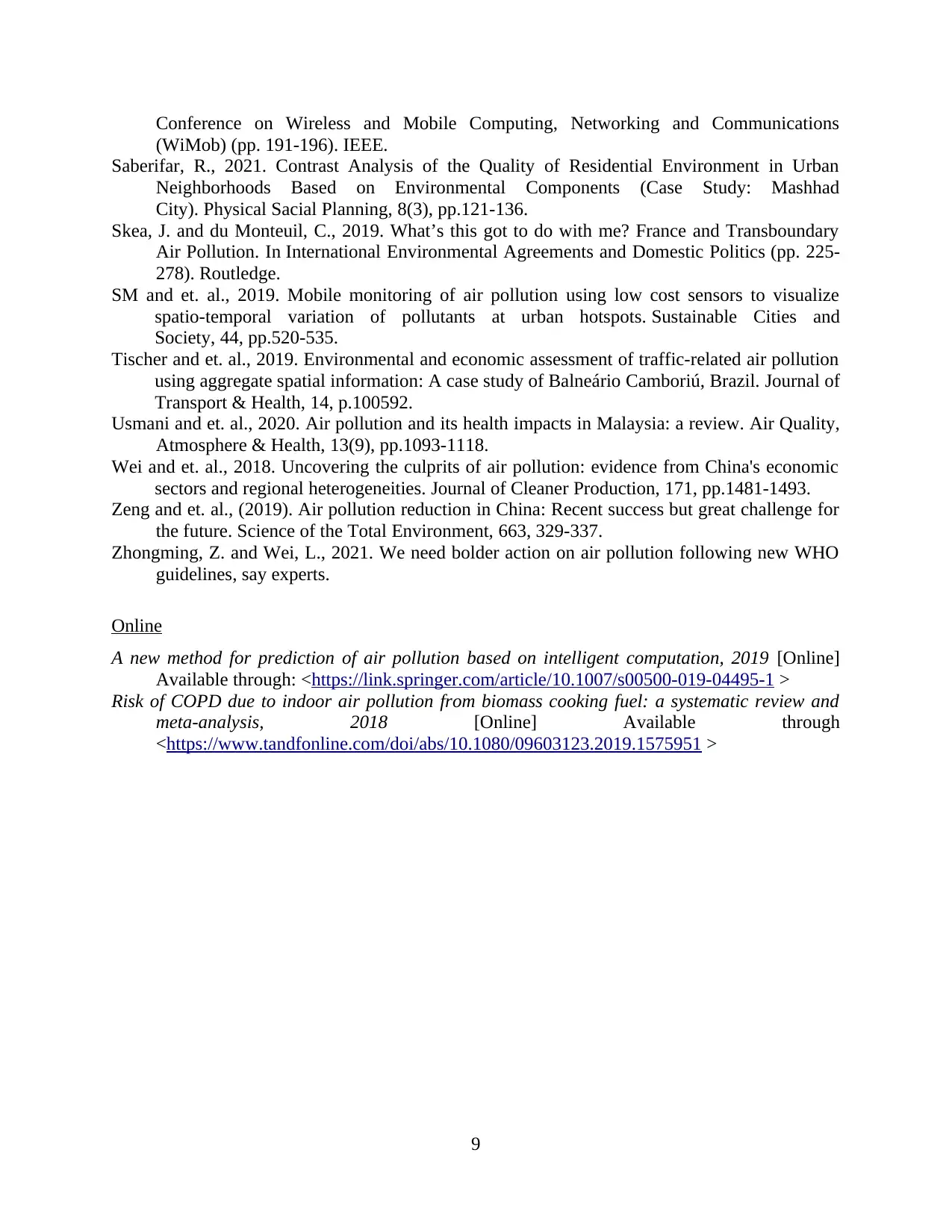
Conference on Wireless and Mobile Computing, Networking and Communications
(WiMob) (pp. 191-196). IEEE.
Saberifar, R., 2021. Contrast Analysis of the Quality of Residential Environment in Urban
Neighborhoods Based on Environmental Components (Case Study: Mashhad
City). Physical Sacial Planning, 8(3), pp.121-136.
Skea, J. and du Monteuil, C., 2019. What’s this got to do with me? France and Transboundary
Air Pollution. In International Environmental Agreements and Domestic Politics (pp. 225-
278). Routledge.
SM and et. al., 2019. Mobile monitoring of air pollution using low cost sensors to visualize
spatio-temporal variation of pollutants at urban hotspots. Sustainable Cities and
Society, 44, pp.520-535.
Tischer and et. al., 2019. Environmental and economic assessment of traffic-related air pollution
using aggregate spatial information: A case study of Balneário Camboriú, Brazil. Journal of
Transport & Health, 14, p.100592.
Usmani and et. al., 2020. Air pollution and its health impacts in Malaysia: a review. Air Quality,
Atmosphere & Health, 13(9), pp.1093-1118.
Wei and et. al., 2018. Uncovering the culprits of air pollution: evidence from China's economic
sectors and regional heterogeneities. Journal of Cleaner Production, 171, pp.1481-1493.
Zeng and et. al., (2019). Air pollution reduction in China: Recent success but great challenge for
the future. Science of the Total Environment, 663, 329-337.
Zhongming, Z. and Wei, L., 2021. We need bolder action on air pollution following new WHO
guidelines, say experts.
Online
A new method for prediction of air pollution based on intelligent computation, 2019 [Online]
Available through: <https://link.springer.com/article/10.1007/s00500-019-04495-1 >
Risk of COPD due to indoor air pollution from biomass cooking fuel: a systematic review and
meta-analysis, 2018 [Online] Available through
<https://www.tandfonline.com/doi/abs/10.1080/09603123.2019.1575951 >
9
(WiMob) (pp. 191-196). IEEE.
Saberifar, R., 2021. Contrast Analysis of the Quality of Residential Environment in Urban
Neighborhoods Based on Environmental Components (Case Study: Mashhad
City). Physical Sacial Planning, 8(3), pp.121-136.
Skea, J. and du Monteuil, C., 2019. What’s this got to do with me? France and Transboundary
Air Pollution. In International Environmental Agreements and Domestic Politics (pp. 225-
278). Routledge.
SM and et. al., 2019. Mobile monitoring of air pollution using low cost sensors to visualize
spatio-temporal variation of pollutants at urban hotspots. Sustainable Cities and
Society, 44, pp.520-535.
Tischer and et. al., 2019. Environmental and economic assessment of traffic-related air pollution
using aggregate spatial information: A case study of Balneário Camboriú, Brazil. Journal of
Transport & Health, 14, p.100592.
Usmani and et. al., 2020. Air pollution and its health impacts in Malaysia: a review. Air Quality,
Atmosphere & Health, 13(9), pp.1093-1118.
Wei and et. al., 2018. Uncovering the culprits of air pollution: evidence from China's economic
sectors and regional heterogeneities. Journal of Cleaner Production, 171, pp.1481-1493.
Zeng and et. al., (2019). Air pollution reduction in China: Recent success but great challenge for
the future. Science of the Total Environment, 663, 329-337.
Zhongming, Z. and Wei, L., 2021. We need bolder action on air pollution following new WHO
guidelines, say experts.
Online
A new method for prediction of air pollution based on intelligent computation, 2019 [Online]
Available through: <https://link.springer.com/article/10.1007/s00500-019-04495-1 >
Risk of COPD due to indoor air pollution from biomass cooking fuel: a systematic review and
meta-analysis, 2018 [Online] Available through
<https://www.tandfonline.com/doi/abs/10.1080/09603123.2019.1575951 >
9
1 out of 11
Related Documents
Your All-in-One AI-Powered Toolkit for Academic Success.
+13062052269
info@desklib.com
Available 24*7 on WhatsApp / Email
![[object Object]](/_next/static/media/star-bottom.7253800d.svg)
Unlock your academic potential
Copyright © 2020–2026 A2Z Services. All Rights Reserved. Developed and managed by ZUCOL.




